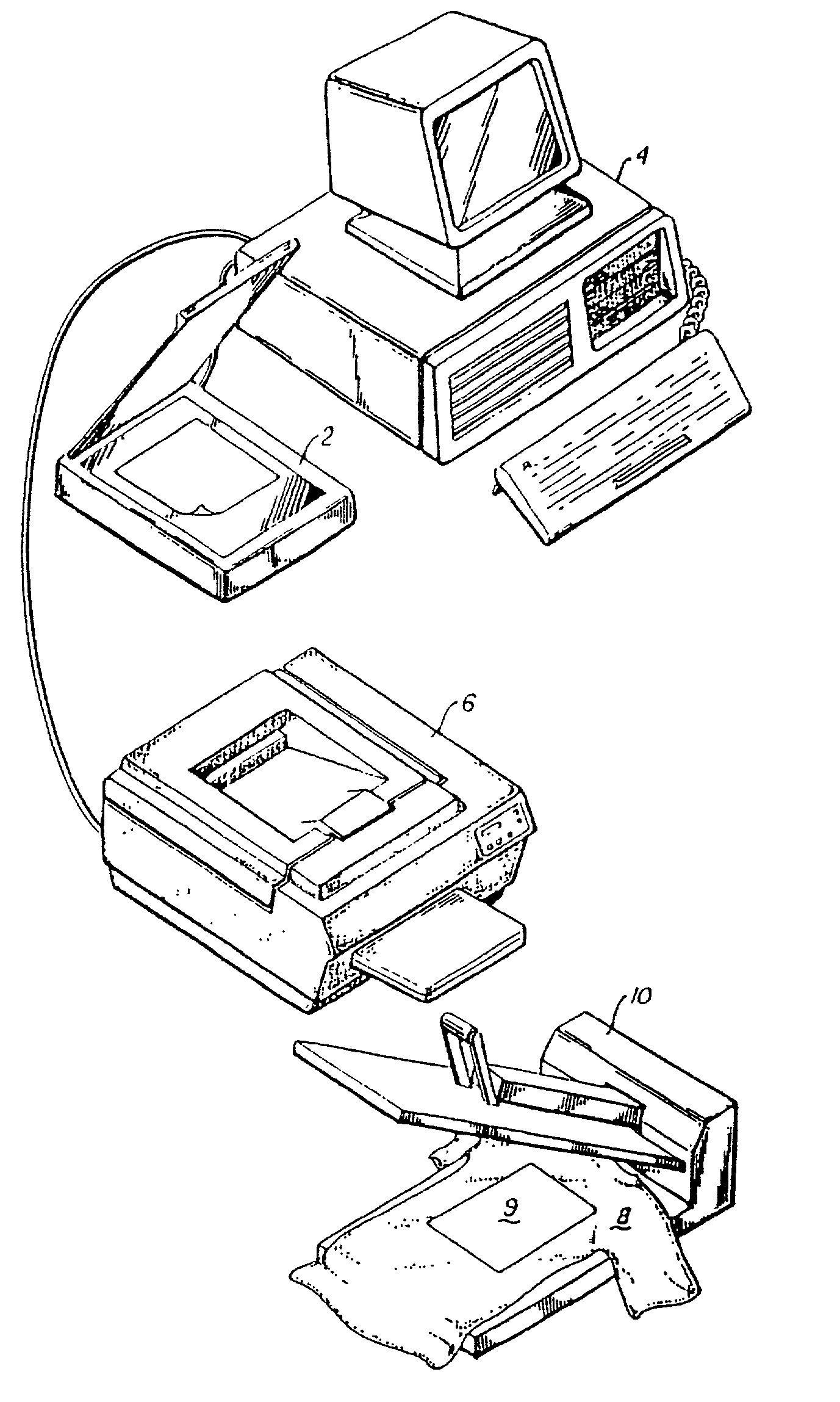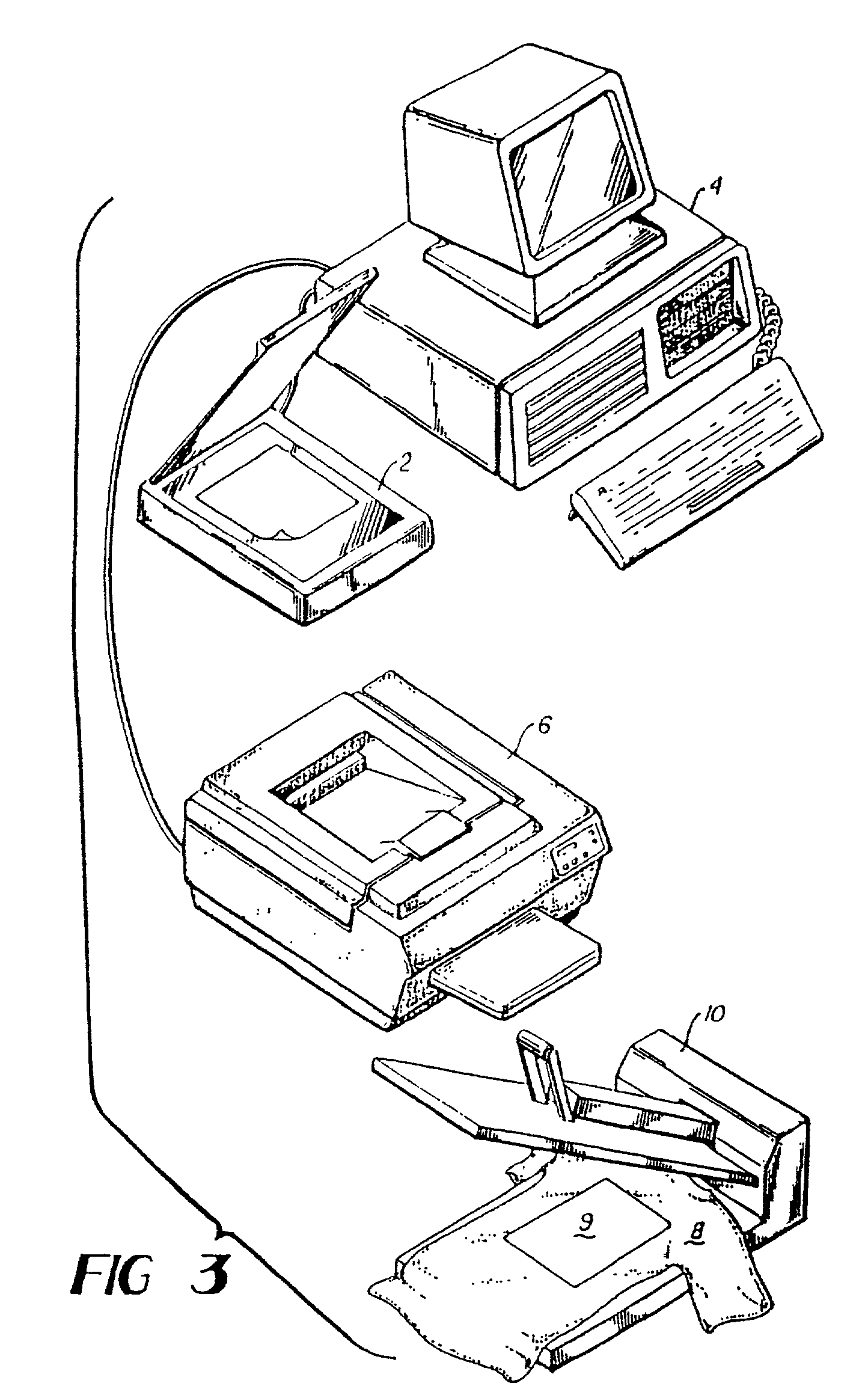Permanent heat activated ink jet printing process
a technology of heat-activated ink and printing process, which is applied in the direction of transfer printing, instruments, inks, etc., can solve the problems of dull colors and inability to meet the requirements of most applications, and achieve the effect of increasing the solubility of ink
- Summary
- Abstract
- Description
- Claims
- Application Information
AI Technical Summary
Benefits of technology
Problems solved by technology
Method used
Image
Examples
formulation example # 3
FORMULATION EXAMPLE #3; Cyan Ink-Jet Formula:
[0049]
5 Material Weight % Sublaprint .RTM. Blue 70013.sup.10 1.0 Lignosol .RTM. FTA.sup.11 3.5 ME .RTM. 39235.sup.12 10.0 Diethylene Glycol 9.5 DMSO 1.0 Distilled H.sub.2O 75.0 TOTAL: 100.00 Sublaprint .RTM. Blue 70013 is a heat activated ink or dye solid. Lignosol .RTM. FTA and ME .RTM. 39235 are emulsifying enforcing agents. Lignosol .RTM. FTA also acts as a fungicide. ME .RTM. 39235 is a polymer, and more specifically, it is a polyethylene binder. Diethylene Glycol and DMSO act as humectants. The solvent is distilled water. .sup.10Keystone Aniline Corporation .sup.11Lignotech (U.S.) Inc. .sup.12Michelman, Inc. Sublaprint .RTM. Blue 70013 is more difficult to sublimate than Bifaxan .RTM. Yellow 3GE, and is less soluble in the emulsifying enforcing agent. Diethylene glycol is used as a humectant to facilitate sublimation of the Sublaprint .RTM. Blue ink solid.
[0050] Sublaprint.RTM. Blue 70013 is a heat activated ink or dye solid. Lignoso...
formulation example # 4
FORMULATION EXAMPLE #4--Magenta Ink-Jet Ink Formula:
[0053]
6 Material Weight % Intratherm .RTM. Brill Red P-31NT.sup.13 .5 Lignosol .RTM. FTA.sup.14 3.0 ME .RTM. 39235.sup.15 11.0 NA-SUL .RTM..sup.16 1.0 DeeFo .RTM. 806-102.sup.17 0.2 Sorbitol 0.5 Dipropylene Glycol 3.5 Distilled H.sub.2O 79.3 TOTAL: 100 .sup.13Crompton & Knowles Corporation .sup.14Lignotech (U.S.) Inc. .sup.15Michelman, Inc. .sup.16King Industries .sup.17Ultra Additives
[0054] Formulation Example #4 comprises a heat activated ink solid or dye which is finely divided and combined in an emulsifying enforcing agent. The emulsifying enforcing agent or medium is, as with Example #3, Lignosol.RTM. FTA and ME.RTM. 39235. Distilled water is used as a solvent. Dipropylene Glycol is used as a humectant.
[0055] Formulation Example #4 further comprises an anti-foaming or foaming control agent, DeeFo.RTM. 806-102 to retard foaming of the liquid ink composition. Formulation Example #4 further comprises a surfactant, which may be So...
PUM
| Property | Measurement | Unit |
|---|---|---|
| diameter | aaaaa | aaaaa |
| temperature | aaaaa | aaaaa |
| temperature | aaaaa | aaaaa |
Abstract
Description
Claims
Application Information
 Login to View More
Login to View More - R&D
- Intellectual Property
- Life Sciences
- Materials
- Tech Scout
- Unparalleled Data Quality
- Higher Quality Content
- 60% Fewer Hallucinations
Browse by: Latest US Patents, China's latest patents, Technical Efficacy Thesaurus, Application Domain, Technology Topic, Popular Technical Reports.
© 2025 PatSnap. All rights reserved.Legal|Privacy policy|Modern Slavery Act Transparency Statement|Sitemap|About US| Contact US: help@patsnap.com



